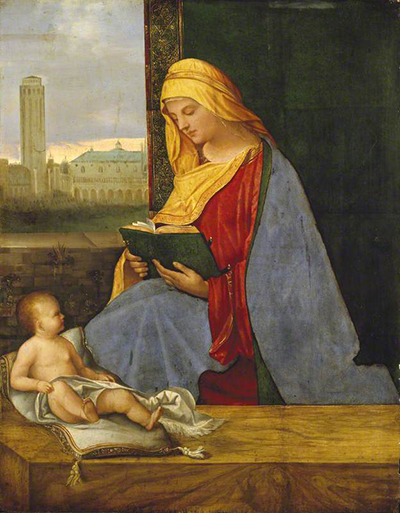The Virgin and Child with a View of Venice is an oil on panel piece by Giorgione from the early 16th century.
This depiction of Mary and Jesus is believed to have been painted by one of Giorgione’s pupils – either Sebastiano del Piombo or Giovanni Cariani whilst other scholars are of the opinion it was Giorgione’s own masterpiece. Also known as ‘The Tallard Madonna’ this artwork is a popular Catholic image. Taking centre stage and the majority of the painting is the Virgin Mary herself. Seated next to her baby, in the South Eastern corner of the Piazza in Venice and dressed in brightly, coloured attire she is reading a book with golden edged pages and a royal emerald cover. Her fingers almost escaping from her clothing to hold the book in question.
She is ultimately dressed in traditional blue with a highly contrasting red and gold headpiece which is intricately edged in matching colours. Her delicate, pale features show concentration in an almost dream like fashion as she peacefully takes in the literature before her. At the Virgin’s knees is the child himself. Placed on luxurious, pale blue cusions which are edged in regal colours and tassels he appears almost aggrieved that his Mother is so embroiled in her reading. As in all traditional paintings and pictures of Jesus he is naked. In this particular depiction he is draped in a matching silken cloth to that of the cushions below.
Beneath him a textured, wooden bench, showing grains and accurate craftsmanship through its painted angles, edges the frame at the bottom of the artwork beautifully. The form of the child takes on cherub like features from his tiny feet and toes, his heavily cushioned legs and torso up to his curly, short hair. His head is covered in curly, short hair but his face seems to take on an almost ‘man like’ expression seeming to glare the Virgin’s way. A walled area sits behind the pair drably thus accentuating the aforementioned Virgin and Child. Known as a cameo view the wall and window frame Venice in all its glory.
A tall, beige structure projects skywards amongst the temporary flat roofed Camponile (1489-1511). Whilst the artist cleverly links Venice with the Virgin birth albeit physically it would have been impossible for this scenario to have occurred. The Virgin and Child with a View of Venice can be viewed at the Ashmolean Museum of Art and Archaeology at the University of Oxford.




